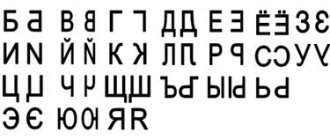Dysgraphia is a pathology associated with writing, which is characterized by the same type of regularly repeated errors with developed intelligence and hearing. This disease is often accompanied by dyslexia (deviations in the reading process).
The causes of the disease can be both biological - difficult pregnancy and childbirth, hereditary diseases, injuries, and psychological and social. For example, if the child has received little attention, there is pedagogical neglect, the child learned to write too early, and so on.
Causes and symptoms of dysgraphia
There are five forms of dysgraphia, which are rarely found in their pure form; they are mostly mixed:
- Acoustic – resulting from impairments in sound recognition.
- Articulatory-acoustic – manifests itself due to disturbances in articulation and phonemic perception.
- Agrammatical – problems in lexical development and grammar development.
- Optical – with undeveloped visual-spatial perception.
- A special form caused by disturbances in language synthesis.
The symptoms of dysgraphia are mostly similar - these are errors in writing that are not associated with ignorance of the rules. A child with dysgraphia misses and confuses letters and syllables, can write words together, and confuse endings and forms. Handwriting suffers, and writing speed is also low.
There are also common symptoms - lack of attention, inability to concentrate on one thing for a long time, poor memory.
Mechanism of occurrence, causes
Writing is a process that requires the coordinated work of the visual, auditory, speech and motor systems. By the time the child masters the basics of writing, he should have mastered oral speech well. If the lateralization of brain functions is not carried out as needed, then a disorder such as dysgraphia develops. Usually these processes are normalized by the time the child begins school.
If the delay in lateralization causes disturbances in a part of the brain, the child develops dysgraphia, which requires correction. Otherwise, the deviation may affect the child’s thinking, memory, and perception.
Causes of occurrence in children
Dysgraphia can be caused by birth trauma. The development of such deviations is provoked by various infectious diseases and improper upbringing. Also, experts do not exclude such a factor as genetic predisposition.
Dysgraphia in children may be accompanied by other concomitant diseases that were previously diagnosed.
Causes of occurrence in adults
In adults, imperfections in written speech can be caused by both internal and external factors. Main reasons for deviation:
- presence of a tumor in the brain;
- low saturation;
- stroke;
- previous brain surgery;
- poor social conditions.
Social factors include insufficient upbringing in childhood, incorrect speech of people around, and lack of communication with others.
With dysgraphia, errors in the process of writing are persistent, despite the fact that the person knows well all the rules of writing words.
Diagnosis of dysgraphia
The diagnosis of dysgraphia is made by a speech therapist after communicating with the child and a series of written tests. The student is asked to write a dictation, rewrite text printed and handwritten, read, and make a written description of the picture. In addition to the speech therapist, it is necessary to show the child to other specialists: an ENT specialist, an ophthalmologist, a neurologist.
Based on the conclusions of doctors and written tests, a conclusion is made and the type and severity of dysgraphia is determined.
Forecast, preventive measures
The prognosis for the treatment of dysgraphia depends on a number of factors: the timeliness of the measures taken, the severity of the deviation, its form, the reasons that provoked the formation of the written speech disorder, as well as the individual characteristics of the patient. Only through the well-coordinated work of specialists, the patience and perseverance of parents, as well as the positive attitude of the child, can a positive result be obtained in the end. The problem associated with impaired written speech can be completely corrected in more than 80% of cases.
Parents of a child who has been diagnosed with dysgraphia should be aware that the lack of a timely response can lead in the future to:
- Poor academic performance, which is fraught with intellectual retardation in the development of the child.
- The appearance of suspiciousness and anxiety.
- The emergence of problems with peers.
In addition, an advanced form of dysgraphia is the cause of a child’s deviant behavior and low self-esteem.
For a child with an advanced form of dysgraphia, the need to write something will always cause discomfort. This leads not only to poor academic performance, but also to a complete lack of desire to learn and master new material.
Correction and correction of dysgraphia at a speech therapy center in Moscow
Dysgraphia cannot be corrected using a school curriculum ; special classes with a speech therapist, physical therapy, and home exercises will be needed. Corrective work on dysgraphia is built individually with each student, since problems with writing can be different, as well as the child’s reaction to corrective classes.
To correct dysgraphia, a speech therapist develops a system for filling gaps that are important for developing writing skills. Additionally, work is being done to develop speech, expand vocabulary, improve attention and memory.
Physical therapy and games with magnet letters are allowed, especially for preschoolers and primary schoolchildren.
Our specialists will help eliminate errors in a child’s writing, expand vocabulary, develop speech hearing, train auditory attention and auditory-speech memory.
Literature
- Korneev A.A., Akhutina T.V., Matveeva E.Yu. Peculiarities of reading of third-graders with different levels of skill development: analysis of eye movements // Bulletin of Moscow University. Episode 14: Psychology. 2019. No. 2. pp. 64–87
- Rybchinskaya E.V., Korneev A.A., Akhutina T.V. Reading regular and irregular words in primary schoolchildren // Eighth International Conference on Cognitive Science, October 18–21, 2022, Svetlogorsk, Russia. Abstracts of reports. 2022. pp. 1246–1248.
- Dorofeeva S.V., Laurinavichyute A., Reshetnikova V., Akhutina TV, Tops W., Dragoy O. Complex phonological tasks predict reading in 7 to 11 years of age typically developing Russian children // Journal of Research in Reading. 2022. Vol. 43, Issue 4. Pp. 516–535
- Kuperman V., Van Dyke JA Effects of individual differences in verbal skills on eye-movement patterns during sentence reading // Journal of memory and language. 2011. Vol. 65(1). pp. 42–73. doi:10.1016/j.jml.2011.03.002
- Moll K. et al. Cognitive mechanisms underlying reading and spelling development in five European orthographies // Learning and Instruction/ 2014. Vol. 2 (9). pp. 65–77.doi:10.1016/j.learninstruc.2013.09.003
Benefits of Dyslexia
For the species Homo sapiens, reading is a relatively recent invention (it appeared along with writing around the 4th millennium BC). During this lesson, our thinking “switches” to a special operating mode. If adults who are far from literature are taught to read, their brains change in a special way. This is shown by the research of Stanislav Diana, a famous French neuroscientist. During the experiment, subjects lost
ability to process certain types of visual information - for example, they became worse at perceiving faces and chessboards.
The skill of reading competes with our other skills, that is, it has its price: you are strong in either one or the other.
The famous artist Maritz Escher is the author of numerous visual paradoxes. He depicted “impossible figures”—three-dimensional objects that are an optical illusion and cannot exist in reality. His famous lithograph "Waterfall", for example, has the structure of a Penrose triangle.
A group of psychologists studied people's ability to recognize such figures. It turned out that dyslexics did much better than others. The researchers hypothesized that this is because they tend to process visual-spatial information not locally (piece by piece), but rather holistically.
So there is a fair amount of truth to the myths that portray people with learning disabilities in a favorable light. For example, there is a rumor on the English-language Internet that more than 50% of NASA employees are dyslexic. “Not true,” NASA tweeted, “but they [dyslexics] are super smart.”
People who have trouble reading actually have some “trump cards” in sciences such as astrophysics.
Researchers have found a link between this disorder and the ability to process information useful in astronomy. For example, dyslexics have outperformed others at finding black holes!
In another study, the authors compared students' ability to remember blurry images that looked like X-rays—and dyslexics again excelled. So their talents can be useful in medicine and in many other fields.
Richard Rogers, the famous architect and one of the creators of the Pompidou Center, is dyslexic. By his own admission, he could not read until the age of 11, and was unable to learn poetry or do homework. They called him stupid. Even as a child, Rogers wanted to throw himself off a roof.
“Dyslexia, however, helped me realize that when people said, 'You're not
you can do it!“ - it was not worth paying attention.
“I don’t take ‘ no
’ too seriously,” Richard said.
He believes that dyslexia allows you to take a broader view of things, forget the “normal” ways of working and turn everything upside down.
The attention of people with a reading disorder is indeed distributed wider than the “norm”. For example, at a cocktail party, a “regular” person will focus on “central” sounds, while a dyslexic person will focus on those in the periphery.
Although the issue has not been sufficiently studied, it is clear that this disorder is associated with features in the functioning of the brain: dyslexia allows you to better see the picture as a whole, rather than in particular, to discover something exceptional and non-trivial, rather than banal and lying on the surface.
Therefore, such people are more likely to think outside the box. American professor Thomas West explains in his book that “out-of-the-box thinking” has always distinguished dyslexics.
When we call some features a disorder, we must remember that this definition is conditional. The same trait can be both a “violation” and an advantage – it all depends on the context and specific tasks. Dyslexia did not prevent molecular biologist Carol Greider and biophysicist Jacques Duboche from becoming Nobel Prize laureates. So no one should feel limited in their studies or career.
Many “disorders” are a normal part of neurodiversity. Our characteristics and differences serve as the driving force of progress, and if everyone had the same brains, humanity would stop in its development.
People are different - and society needs each of them.
Clinical symptoms
The manifestations of dysgraphia and dyslexia are varied, so it is very important to distinguish these disorders from physiological errors in the acquisition of written language. These disorders may be part of more complex neuropsychiatric diseases: mental retardation, mental retardation, etc. The clinical picture is represented by neurological and speech symptoms:
- Impaired coordination of movements.
- Difficulties in remembering rules and rhymes, read words.
- Lack of understanding of what is read and written. In this case, intelligence can be preserved.
- Problems with concentration and distribution of attention, switching it.
- The child confuses the sides.
- While reading and writing, discomfort occurs in the eyes (they may water, there may be pain; the child may bring the book too close or lean too low towards the notebook).
- In the process of reading and writing, the student quickly gets tired and may get a headache.
- The student tries to read and write less; refusals can manifest themselves in the form of negative reactions: aggression, crying.
- The child confuses similar elements.
- Incorrect pronunciation and violation of sound-letter analysis.
The main signs are errors in reading and writing, which differ in specificity. If a child has physiological errors that appear when mastering literacy, then when memorizing the rules, they go away. And with dysgraphia and dyslexia, they are persistent and recurring.
Speech therapy help for dysgraphia
The child must form a word from letters
Exercises to correct writing disorders should be selected depending on the form of the defect. If there is a speech disorder (dysarthria, alalia, etc.), it is necessary to correct it. Sometimes a complex intervention with the participation of a neurologist and neuropsychologist is needed.
- If this is an acoustic form, during lessons the child is offered tasks for correcting phonemic hearing (distinguishing sounds in the speech stream, analyzing the acoustic characteristics of phonemes - similarities and differences, working with paronymous words). They offer tasks to determine the number of sounds in a word and their place.
- If it is articulatory-acoustic dysgraphia, articulation exercises are included in the classes. A more detailed analysis of articulation is carried out with the child. If there are violations of sound pronunciation, mandatory correction is required.
- To correct optical-spatial dysgraphia, they are taught to distinguish between right and left, up and down. They are given tasks to place letters or shapes on sheets of different formats according to verbal instructions. A detailed analysis of the letter: what elements it consists of, in what order to write them. Work is also underway to correct phonetic-phonemic processes.
Also, for any form of writing disorder, in classes the child is asked to lay out letters from scrap materials, sculpt them from plasticine or salt dough. They use the technique of “air writing”: they write letters in the air with their hands; at the initial stages, you can pronounce the writing of the elements. Exercises to improve coordination of movements and develop finger motor skills are required.
How to fix a defect
The work of a speech pathologist is aimed at eliminating identified writing defects. Speech therapy exercises allow you to:
- improve pronunciation and diction;
- develop phonemic awareness (the ability to recognize individual phonemes in oral speech and syllables in written speech);
- enrich vocabulary;
- develop grammatical skills;
- develop coherent storytelling skills.
Correction of dysgraphia is impossible without improving the ability to perceive and analyze other people's speech (oral and written), navigate in space, develop memory and fine motor skills.
After practicing speaking skills, they move on to consolidating them in writing. If the cause of dysgraphia is a somatic disease, medication, physiotherapy, massage and exercise therapy are required.
Etiology of defects
Difficulties in mastering reading and writing skills are due to a number of organic or social reasons:
- Organic damage and underdevelopment of the cortical areas of the brain involved in the process of reading and writing.
- Immaturity of the cortical areas involved in the formation of written speech.
- Somatic weakness of the child.
- Incorrect speech environment in which the child grows up.
- Speech disorders.
- Bilingualism.
- Unfavorable social situation in the family.
Depending on the etiology of the violation, a corrective work plan is drawn up. By eliminating the cause of the reading and writing disorder, you can correct the defect itself. Each form of these violations has its own specific causes, on the basis of which correctional work is based.
A FEW EXERCISES to help overcome dysgraphia
I would like to warn you that these exercises will not eliminate the problem, but will help parents in overcoming dysgraphia and will help the speech therapist work on the defect.
1) Exercise “Proofreading”. For this exercise you need a book, boring and with a fairly large (not small) font. The student works every day for five (no more) minutes on the following task: crosses out the given letters in a continuous text. You need to start with one letter, for example, “a”. Then “o”, then the consonants with which there are problems, first they also need to be asked one at a time. After 5-6 days of such classes, we switch to two letters, one is crossed out, the other is underlined or circled. The letters should be “paired”, “similar” in the student’s mind. For example, as practice shows, most often difficulties arise with the pairs “p/t”, “p/r”, “m/l” (spelling similarity); “y/d”, “y/y”, “d/b” (in the latter case, the child forgets whether the tail of the circle is pointing up or down), etc. The pairs necessary for working through can be established when viewing any text written by your child. After seeing the correction, ask what letter he wanted to write here. More often than not, everything is clear without explanation. Attention! It’s better if the text is not read (that’s why the book needs to be boring). All attention must be concentrated on finding the given shape of a letter, one or two, and work only with them. 2) Exercise “Write out loud.” An extremely important and irreplaceable technique: everything that is written is spoken out loud by the writer at the time of writing and the way it is written, with underlining and highlighting weak parts. That is, “Another O-din h-rez-you-cha-Y-but-important reception” (after all, in fact, we say something like “LOOKING FOR AN EMERGENCY IMPORTANT PREMIERE”). The example is simpler: “ON THE TABLE WAS A JUG WITH MILK” (a jug of malak melted on the steel). By “weak beats” we mean sounds that, when pronounced in fluent speech, the speaker pays the least attention to. For vowel sounds, this is any unstressed position; for consonants, for example, a position at the end of a word, such as “zu*p”, or before a voiceless consonant, such as “lo*shka”. It is also important to clearly pronounce the end of the word, since for a dysgraphic person it is difficult to finish the word to the end, and often for this reason the habit of “putting sticks” is developed, i.e. add an indefinite number of squiggle sticks to the end of a word, which at a quick glance can be mistaken for letters. But the number of these squiggles and their quality do not correspond to the letters at the end of the word. It is important to determine whether your child has developed this habit. However, regardless of whether it exists or not, we get used to consistency and gradual pronunciation, we pronounce every word we write down! 3) “Take a closer look and figure it out” (punctuation for dysgraphics and not only). Material for work - collections of dictations (with commas already added, and check that there are no typos). Assignment: carefully reading, “photographing” the text, explain the placement of each punctuation mark out loud. It is better (for middle and older age) if the explanation sounds like this: “The comma between the adjective “clear” and the conjunction “and”, firstly, closes the participial phrase “...”, and secondly, separates the two parts of the complex sentence ( grammatical basics: the first “…”, the second “…”), connected by the conjunction “and”. 4) “Missing letters.” When performing this exercise, it is suggested to use the hint text, where all the missing letters are in their places. The exercise develops attention and confidence in writing skills. For example:
Of course, no matter what, what Lariosik __to the hall is going to eat. In no way __l__ch__e m__f__t b__t__ n__ st__ro__e Petliura in__el__ig__n__n__y ch__l__we__ in__ob__e, but d__en__lm__n, p__d__i__av__iy cheerful on s__m__es__t p__t you__ya__ and p__sy__a__shchi__ __el__g__a__we in __es__es __t tr__ s__ov__, in ch__st__o__ty... M__shi__nym small__lo__ and k__ro__i__om on__lu__sh__m about__az__m b__li s__aza__y and nay-tours Colt and Al__shin brau__ing . Lariosik, p__d__b__o Nikolka, z__su__il __uk__v__ and p__m__ga__ __maz__va__y and __kl__dy__at__ all__ in d__in__u__ and __y__o__uyu tough__uyu k__rob__u __z-__od ka__am__l__. __ab__ta __y__a sp__shn__y, ib__ to each __ply__och__u chlo__e__u, u__a__your__avsh__mu in rev__i__, o__li__but and__v__st__o, __t__ o__y__ki pr__ __s__h vl__st__h __ro__sho__yat from __wu__ cha__ov t__i__t__ti __in__t __ o__and until __an hour__on Monday__and m__nu__ ut__a z__mo__ and from __day__and th__so__ but__i to __four__h __tra le__o__. V__e ra__ot__ z_-d__rzh__la__y, bl__go__a_-ya Lariosik, who__to__y__, zako__ya__y with __with__ro__st__om activity p__sto__eta with__s__em__ Colt, involved in __y__ku __battle__u not t__m __end__m and, __t__b __ in__ta__it__ e__, __on__do__il__sn__chi__ate__but__ us__le__e and __or__do__but__ to__li__e__t__o m__sl__. Kr__m__ that__o, pr__izol__o in__or__e and n__zhi__a__no__ pr__pya__st__i__: k__ro__k__ with v__o__en__m__ in n__e re__ol__we__am__, p__go__a__i Nikolki and Al__ks__ya, she__ro__om and __ar__o__ko__ __a__le__n__ka A__ek__e__, k__r__b__a, in __lo__e__na__ in__u__r__ __lo__m par__fi__ov__y __um__gi and s__a__zh__ p__ in__e__ __v__m __bl__p__e__na__ li__kim__ __olo__am__ __le__t__i__e__ko__ __z__lya__i, n__ __ro__es__a in f__rto__k__.
5) Labyrinths. Labyrinths are good for developing gross motor skills (movements of the hand and forearm), attention, and continuous line. Make sure your child changes the position of his hand, not the sheet of paper. You can find a variety of labyrinths here.
Dictations must be written! Only in a special way.
- Extremely slow! At the initial stage of eliminating dysgraphia, a dysgraphic applicant should spend at least an hour writing a dictation of 150 words. Why so long? This can be seen from the following points.
- The text is read in its entirety. You can ask what spelling/punctuation this text is based on. Your student is unlikely to answer, since he has already decided that this is “not for him,” so remember and lightly point out them yourself, find out whether the concepts of “unstressed vowels” and “participial/adverbial phrase” are known. Then the first sentence is dictated. Ask the student to name the number of commas in it and try to explain them. Do not insist, suggest, encourage the attempt to give the correct answer. Ask them to spell one or two difficult (or simply long) words. Only then (after reading it twice, or even three or four times).
- The sentence is dictated in parts and written down with all the pronunciation features and punctuation marks spoken out loud.
What it is
Dysgraphia is a violation of written speech skills when partial difficulties arise in mastering writing. Characteristic signs are persistent, repeated errors in writing that are not related to the acquisition of spelling norms.
Dyslexia is a disorder in the development of reading skills. It is associated with difficulties in the formation of speech components and improper operation of analyzer systems.
Some experts believe that these disorders are not just pathologies, but a gift that you need to know how to use. They are not an indicator of low intelligence - these difficulties can occur in children with normal mental development. During diagnosis, it is important to determine whether it is dysgraphia and dyslexia, or physiological errors that are the norm when learning written language.
Teaching children to write without mistakes
1) Exercise “Proofreading”. For this exercise you need a book, boring and with a fairly large (not small) font. The student works every day for five (no more) minutes on the following task: crosses out the given letters in a continuous text. You need to start with one letter, for example, “a”. Then “o”, then the consonants with which there are problems, first they also need to be asked one at a time. After 5-6 days of such classes, we switch to two letters, one is crossed out, the other is underlined or circled. The letters should be “paired”, “similar” in the student’s mind. For example, as practice shows, most often difficulties arise with the pairs “p/t”, “p/r”, “m/l” (spelling similarity); “y/d”, “y/y”, “d/b” (in the latter case the child forgets whether the tail of the circle is pointing up or down), etc.
The pairs required for development can be established when viewing any text written by your child. After seeing the correction, ask what letter he wanted to write here. More often than not, everything is clear without explanation.
Attention! It’s better if the text is not read (that’s why the book needs to be boring). All attention must be concentrated on finding the given shape of a letter, one or two, and work only with them.
2) Exercise “Write out loud.” An extremely important and irreplaceable technique: everything that is written is spoken out loud by the writer at the time of writing and the way it is written, with underlining and highlighting weak parts.
That is, “Another O-din h-rez-you-cha-Y-but-important reception” (after all, in fact, we say something like “LOOKING FOR AN EMERGENCY IMPORTANT PREMIERE”). The example is simpler: “ON THE TABLE WAS A JUG WITH MILK” (a jug of malak melted on the steel).
By “weak beats” we mean sounds that, when pronounced in fluent speech, the speaker pays the least attention to. For vowel sounds, this is any unstressed position; for consonants, for example, a position at the end of a word, such as “zu*p”, or before a voiceless consonant, such as “lo*shka”. It is also important to clearly pronounce the end of the word, since for a dysgraphic person it is difficult to finish the word to the end, and often for this reason the habit of “putting sticks” is developed, i.e. add an indefinite number of squiggle sticks to the end of a word, which at a quick glance can be mistaken for letters. But the number of these squiggles and their quality do not correspond to the letters at the end of the word. It is important to determine whether your child has developed this habit. However, regardless of whether it exists or not, we get used to consistency and gradual pronunciation, we pronounce every word we write down!
3) “Take a closer look and figure it out” (punctuation for dysgraphics and not only).
Material for work - collections of dictations (with commas already added, and check that there are no typos).
Assignment: carefully reading, “photographing” the text, explain the placement of each punctuation mark out loud. It is better (for middle and older age) if the explanation sounds like this: “The comma between the adjective “clear” and the conjunction “and”, firstly, closes the participial phrase “...”, and secondly, separates the two parts of the complex sentence ( grammatical basics: the first “…”, the second “…”), connected by the conjunction “and”.
4) “Missing letters.”
When performing this exercise, it is suggested to use the hint text, where all the missing letters are in their places. The exercise develops attention and confidence in writing skills.
For example:
Of course, no matter what, what Lariosik __to the hall is going to eat. In no way __l__ch__e m__f__t b__t__ n__ st__ro__e Petliura in__el__ig__n__n__y ch__l__we__ in__ob__e, but d__en__lm__n, p__d__i__av__iy cheerful on s__m__es__t p__t you__ya__ and p__sy__a__shchi__ __el__g__a__we in __es__es __t tr__ s__ov__, in ch__st__o__ty... M__shi__nym small__lo__ and k__ro__i__om on__lu__sh__m about__az__m b__li s__aza__y and nay-tours Colt and Al__shin brau__ing .
5) Labyrinths.
Labyrinths are good for developing gross motor skills (movements of the hand and forearm), attention, and continuous line. Make sure your child changes the position of his hand, not the sheet of paper.
Dictations must be written!
- Extremely slow!
- The text is read in its entirety. You can ask what spelling/punctuation this text is based on. Most likely the child will refuse, will not be able to do this, so remember and lightly point out them yourself, find out whether the concepts of “unstressed vowels” and “participial/adverbial phrase” are known. Then the first sentence is dictated. Ask your child to name the number of commas in it and try to explain them. Do not insist, suggest, encourage the attempt to give the correct answer. Ask them to spell one or two difficult (or simply long) words. Only then (after reading it twice, or even three or four times).
- The sentence is dictated in parts and written down with all the pronunciation features and punctuation marks spoken out loud.
Speech therapist Polya Yana Borisovna of the Center for Natural Development and Child Health







